#ahead of his time
In a 1933 interview, Nikola Tesla was asked how it felt to be so far ahead of his time that he was subject to attacks upon his sanity. Tesla replied that he had long since ceased to regard it as important.

“I live a life of seclusion. The opinion of the world does not affect me. I have placed as the real values in my life what follows after I am dead, although it has been given to me to live to see those things which were once scouted accepted as scientific dogmas.
“The thing that recompenses me is that my name shall be known to generations yet unborn for the Tesla Coil, Tesla Motor, and perhaps my name will be connected to the absolutely new source of power I am about to present to the world. It is this thought in which I find happiness and health. A pioneer does not apply his energies in the way the world is going. Rather, he goes against the current. He lets them call him a lunatic. He lets them trample him—if I should ever tell you the inside story of how I had been trampled—but never mind, it was all good for me. I have come through it. I am able to work harder than I worked a year ago. I work now with greater energy and get results more easily than ever before in my life.
"…After all, they have called me a lunatic before. What is one last time?“
–Nikola Tesla
“Tesla Predicts New Source of Power In Year.” New York Herald Tribune. July 9, 1933.
Nikola Tesla Explaining How Guglielmo Marconi Copied His Wireless System

“Now, it is important to give you a clear idea of the differences between the apparatus I produced and the contemporary apparatus. I have selected just these diagrams to give you, in a few words, the exact differences between the system I have developed and the system illustrated below in this diagram, which is typical of the systems that had been used prior to my invention.
"This upper diagram is taken from my patents, and this lower drawing from a patent of Marconi which appeared in 1901. Certainly, it is proper to compare his arrangements with mine because they are used at the time when I brought out these principles.
"As you see, here in this figure on the right is my conductor connected to the ground and to the antenna, with absolutely no break in it. This other [in Marconi patent drawing] is a conductor connected to the antenna and the ground with a break in it. It cannot compare with mine because that break means resistance and diminution of the resonant rise. Furthermore, note the difference that I have here—the primary energy passing into a transformer—and that these two circuits are tuned. There is no primary or a transformer in this Marconi arrangement. It is a wasteful system to begin with.
"At the receiving end, as you see, I have again an antenna and a self-inductance in series with the ground and no break. He has a wire connected to the ground and to an antenna, a break or device of high, very high resistance with which it is absolutely impossible to obtain any practical results.
"My system is a system which can be perfectly attuned, and it will transmit to this antenna, here at the left, hundreds of thousands of times, millions of times, the energy which his device can transmit to his receiver.
"Furthermore, my system is a system which is exclusive, which can be tuned and rendered private; that of Marconi can not be tuned. Moreover, his transmitter generates electromagnetic waves a very high frequency, which are absorbed in the air and penetrate only a few miles, while mine produces current waves which pass to the opposite point of the glow with the greatest facility, and can affect instruments at any distance.
"If you take these two contemporaneous diagrams, and examine the subsequent developments, you will find that absolutely not a vestige of the apparatus of Marconi remains, and that in all the present systems there is nothing but my four-tuned circuits. Everybody is using them.
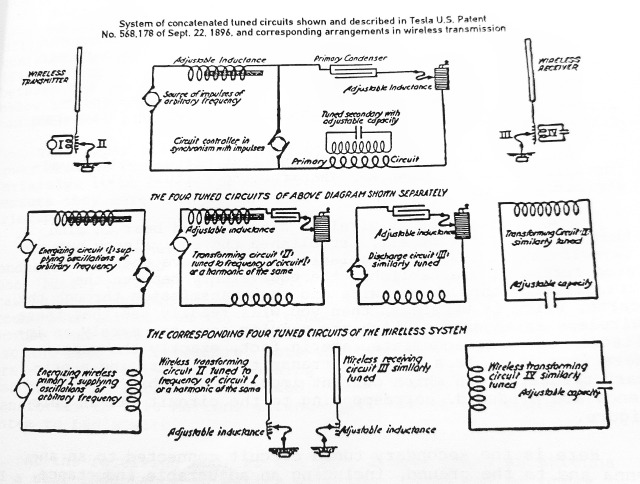
"Every wireless message that has ever been transmitted to any distance has been transmitted by this apparatus; there is no other way. Mr. Marconi came here when he announced that he had made a transmission across the Atlantic. I congratulated him. I said to my secretary, "I can not understand how Marconi could obtain these results. His apparatus cannot do this; he must use my apparatus.” My secretary said, “How can Marconi use your apparatus when here is his statement that he had tried it and it did not work did not work?” But, when you examine the publications of a year later, you will note Marconi comes out with the statement that he had used these four circuits, and the only excuse that he has put up is that he did not know that these four circuits had to be attuned. That was his excuse. In the meantime, he had been using this apparatus. Every message that has ever been transmitted to any distance, by telegraph or telephone—wireless, has been by the use of these instrumentalities and no others.“
(Nikola Tesla in a pre-hearing interview with his legal counsel in 1916 to protect his radio patents from Guglielmo Marconi. “Nikola Tesla On His Works With Alternating Currents and Their Application to Wireless Telegraphy, and Transmission of Power.” Twenty First Century Books, Breckenridge, Colorado, 2002.)
Nikola Tesla in a pre-hearing interview with his legal counsel in 1916 to protect his radio patents from Guglielmo Marconi

Tesla: “This is the transmitter which was already so far developed that I obtained discharges of 16 feet and a tension of 4 million volts. The secondary flat spiral usually connects to the antenna, and this coil on the vertical stand is another tuning coil to adjust the oscillations to a low frequency. Now, it is a mere matter of proportioning this circuit to the antenna in order to transmit, with the same apparatus I built in 1895, 1896, in 1897, messages across the Atlantic with the greatest facility. I will agree at any time to construct an apparatus exactly as I have described at that time and, without the slightest change, I will affect transmission across the Atlantic as easily as rolling off a log.”
Counsel: “Is that a spark apparatus?”
Tesla: “Yes, in this instance it was a spark apparatus; but I operated it also without a spark, with alternating current. I operated it with damped waves or with undamped waves. But remember that I had a system with small capacity, large self induction—no outflow of energy. Energy could not radiate; that is the reason why I got this tremendous pressure which you cannot get in an antenna which radiates too much energy in electromagnetic waves.”
Counsel: “ Mr. Tesla, speaking about that apparatus you said that the energy could not get out. How was the transmission then made, as for instance, across the Atlantic, or elsewhere? Is it through these earth currents that you spoke of?”
Tesla: Yes of course, through the earth currents. If I simply generated electromagnetic waves, I would be in the same box that Marconi is in, or anybody else; I would have to use an awful lot of power and I would not be able to get across. I would have to use a bigger apparatus. But, if I adapt this apparatus to the antenna in the way I want to adapt it, there is no difficult of transmitting across the Atlantic with this very same apparatus.“
Counsel: ” I do not yet get quite clear just what the effect is of keeping the energy from leaking out from the antenna.“
Tesla: "Well, sir, I have given you the simplest mathematical formula which, of course, experts are perfectly familiar with. You are not. Now, let me explain.
"If we put it in an equation, we will have on one side the decrement of the antenna, and on the other the resistance of the antenna multiplied by the square root of the capacity divided by the self-induction…”
(“Nikola Tesla On His Works With Alternating Currents and Their Application to Wireless Telegraphy, and Transmission of Power.” Twenty First Century Books, Breckenridge, Colorado, 2002.)
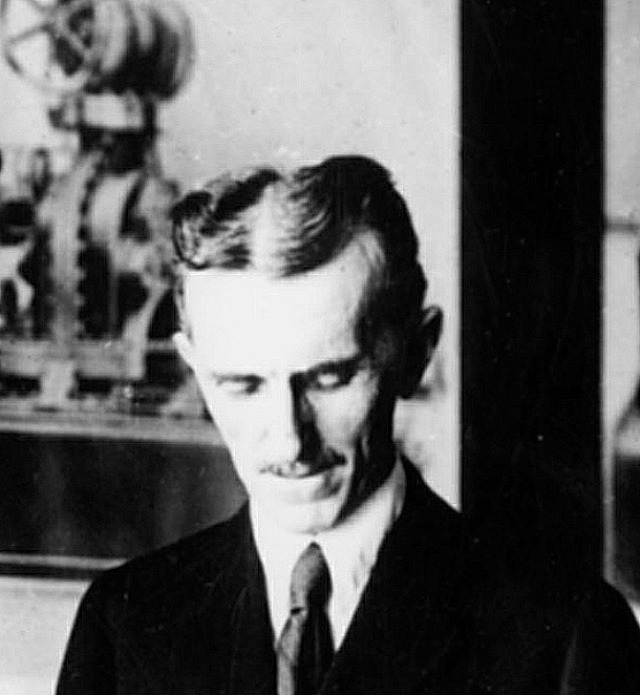
“My sight and hearing were always extraordinary. I could clearly discern objects in the distance when others saw no trace of them. Several times in my boyhood I saved the houses of our neighbors from fire by hearing the faint crackling sounds which did not disturb their sleep, and calling for help. In 1899, when I was past 40 and carrying on my experiments in Colorado, I could hear very distinctly thunderclaps at a distance of 550 miles. The limit of audition for my young assistants was scarcely more than 150 miles. My ear was thus over thirteen times more sensitive. Yet at that time I was, so to speak, stone deaf in comparison with the acuteness of my hearing while under the nervous strain. In Budapest I could hear the ticking of a watch with three rooms between me and the time-piece. A fly alighting on a table in the room would cause a dull thud in my ear. A carriage passing at a distance of a few miles fairly shook my whole body. The whistle of a locomotive 20 or 30 miles away made the bench or chair on which I sat vibrate so strongly that the pain was unbearable. The ground under my feet trembled continuously. I had to support my bed on rubber cushions to get any rest at all. The roaring noises from near and far often produced the effect of spoken words which would have frightened me had I not been able to resolve them into their accidental components. The sun’s rays, when periodically intercepted, would cause blows of such force on my brain that they would stun me. I had to summon all my will power to pass under a bridge or other structure as I experienced a crushing pressure on the skull. In the dark I had the sense of a bat and could detect the presence of an object at a distance of 12 feet by a peculiar creepy sensation on the forehead. My pulse varied from a few to 260 beats and all the tissues of the body quivered with twitches and tremors which was perhaps the hardest to bear.”
–Nikola Tesla
“My Inventions V – My Later Endeavors.” Electrical Experimenter, February, 1919.

Rest in paradise, Nikola Tesla (January 7, 1943).

“Even the gods of old, in the wildest imaginings of their worshipers, never undertook such gigantic tasks of world-wide dimensions as those which Tesla attempted and accomplished.”
–John J. O'Neill. “Prodigal Genius: The Life of Nikola Tesla.” 1944.
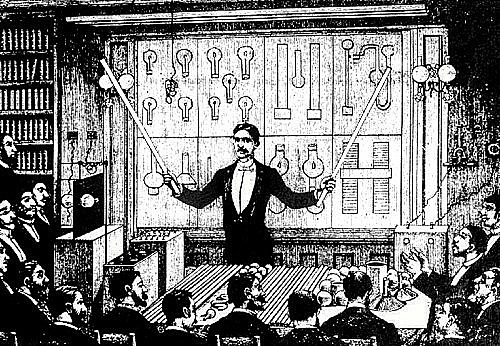

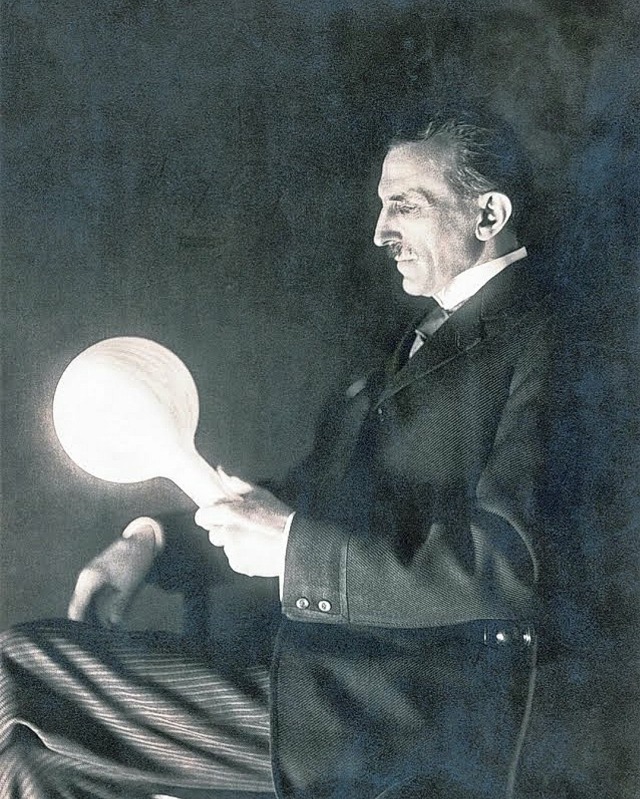



“The progressive development of man is vitality dependent on invention. It is the most important product of his creative brain. Its ultimate purpose is the complete mastery of mind over the material world, the harnessing of the forces of nature to human needs. This is the difficult task of an inventor who is often misunderstood and unrewarded. But he finds ample compensation in the pleasing exercise of his powers and in the knowledge of being one of that exceptionally privileged class without whom the race would have long ago perished in the bitter struggle against pitiless elements.”
–Nikola Tesla
“My Inventions I – My Earlier Life.” Electrical Experimenter, February, 1919.

American writer Samuel Clemens, aka Mark Twain, is pictured here in Nikola Tesla’s laboratory experimenting with lamps lighted by electric currents passed through his own body. Mr. Clemens holds a loop of bare wire in his hands. Currents are induced in the loop by means of a resonating coil over which the loop is held. These currents traverse the body of the Mr. Clemens, and at the same time, as they pass between his bare hands, they bring two or three lamps held there to bright incandescence. Although the currents experimented with are of a voltage in the hundreds of thousands, they do not distress the experimenter in the slightest. The extremely high tension of the currents which Mr. Clemens is seen receiving prevents them from doing any harm to him.

“The human mind thinks but to complicate. As soon as one problem is solved, that solution introduces new complications, other problems that perhaps did not exist before. That was one of my great troubles when I was younger, I invented many things that were very fine, but always I was getting into complications. I have had to work very hard to overcome that.“
–Nikola Tesla
“Dr. Tesla Talks Gas Turbines.“ Motor World, September 18, 1911.

“Too much leisure, and civilization will go to pot. Man was born to work, suffer and struggle, and if he doesn’t he’ll go under.”
–Nikola Tesla
“Great Scientific Discovery Impends.” Sunday Star, Washington D.C., May 17, 1931.

“In how far we can understand the universe around us is the ultimate thought of every student of nature. The coarseness of our senses prevent us from recognizing the ulterior construction of matter, and astronomy, this grandness and most positive of Natural Sciences, can only teach us something that happens, as it were, in our immediate neighborhood; of the remoter portions of the boundless universe, with its numberless stars and suns, we know nothing. But far beyond the limit of perception of our senses the spirits still can guide us, and so we may hope that even these unknown worlds – infinitely small and great – may in a measure become known to us. Still, even if this knowledge should reach us, the searching mind will find a barrier, perhaps forever unsurpassable, to the true recognition of that which seems to be, the mere appearance of which is the only slender basis of all our philosophy.”
—Nikola Tesla
“Experiments With Alternating Currents of Very High Frequency and Their Application to Methods of Artificial Illumination.” A lecture delivered before the American Institute of Electrical Engineers, at Columbus College, N.Y., May 20, 1891.

Christmas gift from the fiancé! Can’t wait to frame these and hang them up. Happy holidays everyone!
“It is necessary for us to assume a universal medium for the transmission of force. This results from the necessity of explaining the action of bodies at a distance. Energy transmitted from the sun to the earth through some very attenuated medium. To show how such medium may be used under certain conditions I may refer to a feat I once accomplished of converting a column of gas into a solid body by the application of electricity in a certain manner. The gas became rigid and vibrated like a steel wire. Scientific men have not noticed the importance of this as yet. Again, I have produced a solid body in the air on the end of a wire. I made a flame which consumed nothing and which showed signs of solidification, for it offered resistance to the passage of bodies through it.”
–Nikola Tesla
“Tesla’s Visit To Chicago.” Western Electrician, May 20, 1899.

Nikola Tesla’s Egg of Columbus

The “Egg of Columbus”is a hearsay story originating in the 16th century about the infamous Christopher Columbus and his nautical explorations into the New World. As to be expected, Columbus was met with several doubters who did not believe he would find a new trade route, despite his convincing propositions. In order to stand his ground, Columbus challenged these critics with a tactical game of sorts: if these naysayers could stand an egg upright with no outside assistance, then Columbus would agree with their claims that no new trade routes existed. After many attempts, the challengers eventually gave up. Columbus then grabbed the egg and very lightly cracked the tip of the egg and it miraculously stood independently. With this trick, Columbus was subsequently allowed to meet the queen, who thus pawned her jewels and funded his expedition. This story originated in Italy, but is a prime example of an early American folk story of motivation and inspiration, conveying that, although things seem impossible at first, anything is possible with the right skill.
In the late 1880s, Nikola Tesla, who was in dire need of funds at the time to continue to foster his scientific research and experiments, found himself in a similar situation as Columbus. Specifically on one occasion, he was at dinner with wealthy capitalists who were skeptical of his various technical propositions. Tesla’s induction motor was such a new concept that it was difficult to comprehend by the layperson, and thus challenging to obtain support by the general public. Alternating current (AC) power was not a new concept at the time; however, Tesla had discovered the “rotating magnetic field” which made AC motors significantly more efficient and was an entirely new product of commercial value. To gain these wealthy investor’s trust, Nikola Tesla asked them if they were aware of the story of “The Egg of Columbus.”
“Of course!” they remarked.
With confidence in his stature, Tesla replied, “Well, if I could outdo Columbus and stand an egg up without cracking the egg, would you give me a chance?”
“We do not have the fortune of a queen, but if you could entertain us with this we would absolutely put our investments in you.”
Tesla then invited them back to his laboratory the next day and had his equipment already configured and eagerly prepared to prove the challenge at hand. He had his new induction motor ready to execute with a wooden table set directly above it, and there was a huge copper egg in the center of the table. The men enthusiastically approached the table and Tesla confidently powered up the induction motor. Slowly, the egg began to rotate, then wobble, and as the motor sped up, the egg began to rotate perfectly on its tip. The investors laughed joyously and hugged in collective amazement.
“You have done it, Mr. Tesla!” they screamed. “We will gladly invest in your motor!”
Later in 1893, Nikola Tesla would display this motor and showcase this same experiment years later at the Chicago’s World Fair. Tesla’s “Egg of Columbus” was a visitor’s favorite. Not only would he rotate one copper egg in the magnetic field, but he would also set in motion multiple eggs of different proportions in rotations; the smaller eggs would rotate and circle around the bigger egg reminiscent of a mini solar system. This was in part how he developed his dynamic theory of gravity, a theory he would spend the rest of his life cultivating.
In 1896, Tesla’s AC system of power was put to use and powered Buffalo, NY from Niagara Falls. Today we still use Tesla’s basic system of power transmission.

The New Yorker Hotel:
Nikola Tesla: “Twelve napkins please!”

“If you mean the man who really invented, in other words, originated and discovered — not merely improved what had already been invented by others, then without a shade of doubt, Nikola Tesla is the world’s greatest inventor, not only at present, but in all history.“
“Tesla has secured more than one hundred patents on inventions, many of which have proved revolutionary. Science accords to him over 75 original discoveries, not mere mechanical improvements. Tesla is an originator in the sense that Faraday was an originator. Like the latter he is a pioneer blazing the trail; aside from this he is a discoverer of the very highest order.”
“Ninety percent of the entire electrical industry pays tribute to his genius. All electrical machinery using or generating alternating current is due to Tesla. High tension current transmission without which our long distance trolley cars, our electrified lines, our subways would be impossible, are due to the genius of Tesla. The Tesla Induction Motor, the Tesla Rotary Converter, the Tesla Phase System of Power Transmission, the Tesla Steam and Gas Turbine, the Tesla Coil, and the Oscillation Transformer are perhaps his better known inventions.“
“Why the world at large does not know Tesla, it is answered best by stating that he has committed the unpardonable crime of not having a permanent press agent to shout his greatness from the housetops. Then, too, most of Tesla’s inventions, at least to the public mind, are more or less intangible on account of the fact that they are very technical and, therefore, do not catch the popular imagination, as, for instance, wireless, the X-ray, the airplane, or the telephone.”
”NIKOLA TESLA, in the opinion of authorities, today is conceded to be the greatest inventor of all times. Tesla has more original inventions to his credit than any other man in history. He is considered greater than Archimedes, Faraday, or Edison. His basic, as well as revolutionary, discoveries for sheer audacity have no equal in the annals of the world. His master mind is easily one of the seven wonders of the intellectual world.”
–Hugo Gernsback
“Nikola Tesla and His Inventions — An Announcement.” Electrical Experimenter, January, 1919.
(Hugo was an inventor, writer, editor, and magazine publisher, best known for publications including the first science fiction magazine.)

“It may not be generally known that in my papers published in the Electric Review of New York from 1896 to 1897, long before the discovery of radium by Madame Curie [1898], I demonstrated the existence and describe the salient properties of emanations of the same nature. My views were received with skepticism at that time, but I am glad to say that now they are adopted in their entirety. I see no reason for changing the opinions I then expressed. The so-called radium imitations are not an isolated phenomenon, but are universal. There is, according to my ideas, no such element as radium or polonium, although spectral analysis, the theory of Mendenleff, and various experimental observations, support this modern view. I believe, that as to this, scientific opinions is in error, as it was a century ago, in assuming that there was such a substance as phlogiston concerned in combustion until Lavoisier discovered oxygen. Similarly the radium manifestations are, in all probability, due to the action of a universal medium on certain volatile substances. Much of the speculation based on Madame Curie’s discovery is necessarily erroneous, being in direct contradiction to well established principles. The claims of some enthusiasts that in radium lies the possibility of future power development are nothing but a dream. But the sole fact is that we are in the presence of new and wonderful effects of the study of which is leading us gradually to a better and deeper understanding of the mechanism of the universe.”
–Nikola Tesla
“Nikola Tesla Talks Of The Future Of The Greatest Problems Now Confronting The Scientific World.” By E. Leslie Gilliams. New York Press, March 2, 1913.

Fun fact:
When Nikola Tesla first displayed his idea of remote control to the public in 1898, they all thought he was some kind of crazy magician who trained a small monkey to drive the boat hidden inside .
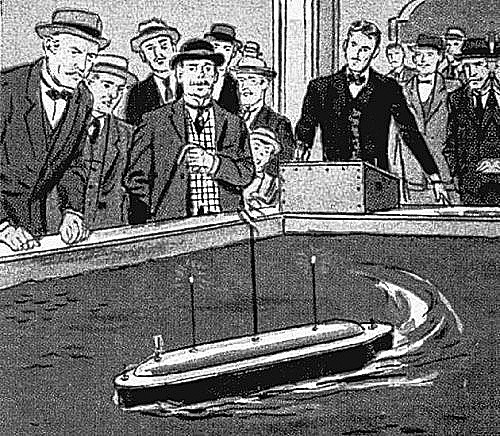

“Every effort under compulsion demands a sacrifice of life-energy. I never paid such a price. On the contrary, I have thrived on my thoughts.”
–Nikola Tesla
“My Inventions I – My Earlier Life.” Electrical Experimenter, February, 1919.

The Tesla Coil
A Method of transformation of electrical energy by oscillatory condenser discharges. It was predicted by Tesla that this apparatus afforded vast possibilities and would play an important part in the future.

“This type of apparatus is identified with my name as certain as the law of gravitation is with that of Newton. I know that some have claimed that Professor Thomson also invented the so-called Tesla coil, but those feeble chirps ne'er went beyond Swampscott. Professor Thomson is an odd sort of man; very ingenious, but he never was a wireless expert; he never could be. Moreover, it is important to realize that this principle is universally employed everywhere. The greatest men of science have told me that this was my best achievement and, in connection with this apparatus I may say that a lot of liberties have been taken. For instance, a man fills this space [break D] with hydrogen; he employs all my instrumentalities, everything that is necessary, but calls it a new wireless system – the Poulsen arc. I cannot stop it. Another man puts in here [referring to space between self-inductive lines L L] a kind of gap – he gets a Nobel prize for doing it. My name is not mentioned. Still another man inserts here [conductor B] a mercury[-arc] rectifier. That is my friend Cooper Hewitt. But, as a matter of fact, those devices have nothing to do with the performance.
“If these men knew what I do, they would not touch my arrangements; they would leave my apparatus as it is. Marconi puts in here [break D] two wheels. I showed only one wheel; he shows two. And he says, “See what happens when the wheels are rotated; a wonderful thing happens!” What is the wonderful thing? Why, when the teeth of the wheels pass one another, the currents are broken and interrupted. That is the wonderful thing that happens? The Lord himself could not make anything else happen unless he broke his own laws. So, in this way, invention has been degraded, debased, prostituted, more in connection with my apparatus than in anything else. Not a vestige of invention as a creative effort is in the thousands of arrangements that you see under the name of other people – not a vestige of invention. It is exactly like in car couplings on which 6,000 patents have been taken out; but all the couplings are constructed and operated exactly the same way. The inventive effort involved is about the same as that of which a 30-year-old mule is capable. This is a fact.
“This is one of the most beautiful things ever produced in the way of apparatus: I take a generator of any kind. With the generator I charge a condensing. Then I discharged to condenser under conditions which result in the production of vibrations. Now, it was no sense Lord Kelvin that the condenser this charge would give this vibration, but I perfected my apparatus to such a degree that it became an instrument utilizable in the arts, In a much broader way than Lord Kelvin had contemplated as possible. In fact, years afterwards when Lord Kelvin honored me by presenting to the British Association one of my oscillators of a perfected form, he said that it was “a wonderful development and destined to be of great importance.”
–Nikola Tesla
(Tesla explaining his wireless art in a pre-hearing interview with his legal counsel in 1916 to protect his radio patents from the Guglielmo Marconi and the Marconi Company.)
“Nikola Tesla On His Works With Alternating Currents and Their Application to Wireless Telegraphy, and Transmission of Power.” Twenty First Century Books, Breckenridge, Colorado, 2002.
“Here is the schematic drawing of the Tesla Transformer with its elevated capacitance and propagating into the Earth. Tesla uses the analogy here of having a large balloon with a hand pump putting pressure waves in and out of the balloon and little pressure gauges all around the planet indicating receiving instruments. And of course, the pointers on the pressure gauges all dance up and down in perfect correspondence with the hand pump. And then of course, we have here the Wardenclyffe Tower attached to the Earth doing the same thing electrically, pumping dielectric energy in and out of the Earth which is captured by small receiving apparatus that take this dielectric induction and convert it back into electrical induction.”
- Eric P. Dollard
“The Principles of Wireless Power” (circa 1986).


